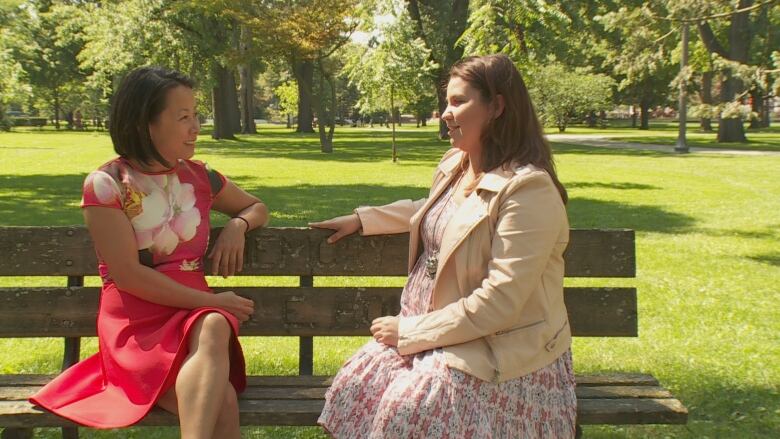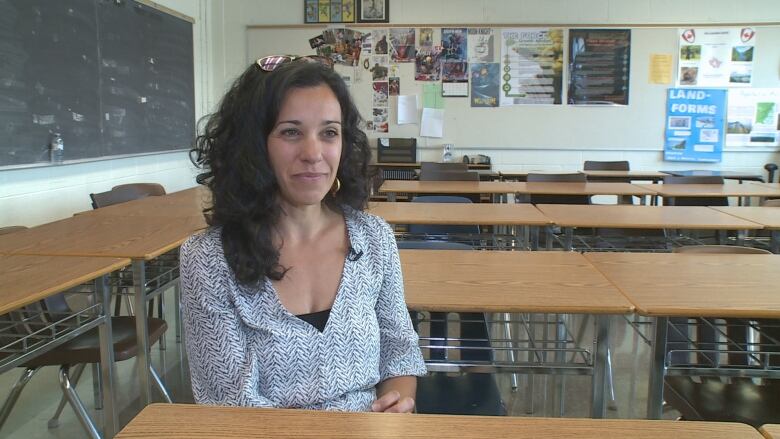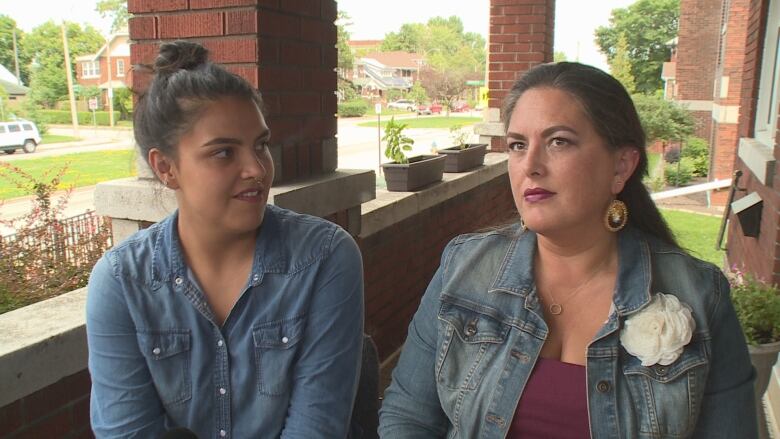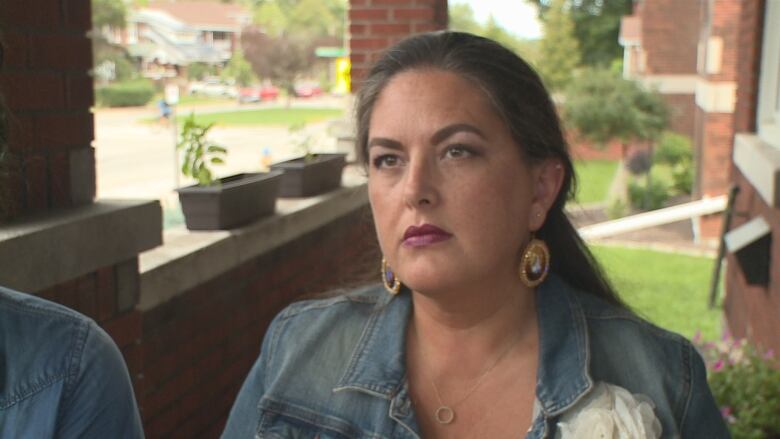Ignoring Indigenous culture leads to classroom disconnect
Number of urban Indigenous population with post-secondary education remains lower than general population

April-SkyeBiolchiniwas bullied so often and so harshly in high school, shecame dangerously close to giving up on her education altogether.
Most of the bullies targeted her because she wasIndigenous, saidBiolchini, who is originally from the Six Nations of the Grand River in southern Ontario.
The 18-year-old recalls struggling toconcentrate in the classroom. She could barelysleep at night and rarely wanted to get out of bed in the morning.
Biolchini's one of manyIndigenous students who struggle to succeed in school because classrooms often ignored their culture, making them feel isolated and ashamed of their identity.
"One of the biggest challenges I had to face was bullying, based on my ethnicity," she said. "Other people sometimes think they have more knowledge than First Nations peoples. They're basically putting you on the outside because they don't think they're the same as you."
Supportive family key to success
Biolchinididn't fit into regular routines. She regularly thought about dropping out of school and aiming for an alternative education, like getting a general education diploma. She would have done anything just to avoid regular school.

Luckily for Biolchini, she graduated from high school in June 2016 and has started an education in Child and Youth Care at St. Clair College this fall. She attributes her success to encouragement from her mother.
Without that support, Biolchini could have ended up like many otherIndigenous students, whodo not graduate from high school.
While graduation numbersare scant because few young people self-identify asIndigenous, leaders in the community say not enoughIndigenous students complete high school.
Graduation rates
Officials from the Greater Essex County District School Board declined to share their numbers, saying the figures could be skewed because many students do not self-identify.
The Windsor-Essex Catholic District School Board provided the graduation rates ofIndigenous students for the last two years:
- 2016: Of 14FNMIeligibleto graduate; 85per cent graduated
- 2015: Of 14FNMIeligible to graduate; 85per centgraduated
- Graduation rate for all students: 87per cent
The latestlong-form census from 2006showed 1,140 self-identified Aboriginal people 15 years or older did not have a certificate, diploma or degree.
Out of the 4,050 self-identified Aboriginal people in the region at that time, the 2006 census showed:
- 1,220 had a high school certificate or equivalent
- 430 had apprenticeship or trades certificate
- 385 had universitycertificateordegree
- 2,360had no post-secondary certificate diploma or degree
Nationally, 2011Statistics Canada figures show 28.9 per cent of Aboriginal people aged 25-34 had "no certificate, diploma or degree" while the proportion for non-Aboriginal people in the same age group was 12.1 per cent.
While Biolchini self-identified as anIndigenous student, many do not, which means the numbers may not represent the actual graduation rate. Both school boards and other agencies in the community are trying to fix that.

Melissa Cavallin is thecurriculum consultant for First Nations, Metis and Inuit (FNMI) students with the Catholic board. She recognizes the need to let students feel comfortable before they will identify asIndigenous.
"We need to understand historical experiences, contemporary issues, the impact of childhood trauma through residential schools," she said. "That will create a more welcoming place, so students feel comfortable enough to self identify."
Russell Nahdee,coordinator of the Aboriginal Education Centre at the University of Windsor, saidstudents need to realize they can go on to post-secondary education.
"We know when they're in the classroom, there isn't anything they're connected to," he said. "We also know, if they're connected in some way to a post-secondary education, that encourages them to continue."
Nahdee, who helps Indigenous students acclimatize to life oncampus both culturally and academically, said there's a number of "complex reasons" why young Indigenous people are not getting higher education, including socioeconomic factors, isolation and the lack of funding.

Shelby-Lynn Soney, with roots in Walpole Island, began her second year of studies at the University of British Columbiathis fall. She grew up in Windsor and had a more positive experience in high school than Biolchini.
Still, she felt similar barriers.
"When you're Indigenous, you have that stereotype," said Soney. "It's a weight on your chest. Am I falling down the wrong path? Am I going to be a stereotype?That's the biggestissuehaving that pressure and overcoming the stereotypes."
Soneywants to see an end to the stigma.
"Stop saying all Indigenous people are uneducated, drunks, yadda, yadda," she said. "Be there to support Indigenous students so we can rise above."
Support systems
Both Biolchini and Soney attribute their success to having strong support systems.
"My mom told me it wasn't a good idea for me to quit high school," said Biolchini. "She wanted me to get the opportunities she didn't get."

Soney said she had group ofsupportivefriends, many of them Indigenous. She also had a fosteringmother, Kanietonhawi Cross, who gave her the right advice.
"If you're not throwing up or totally dying, then you're going to school, even when busses were cancelled," said Cross.
That support needs to continue through post-secondary education, according to the Indigenous students.
"If you want students to go to university, to higher education, they need to have support," said Soney. "UBC has a long house. The University of Windsor has Turtle Island."
"Our children have a really hard time moving away from home," said Cross. "When their home supports are gone, they really don't do well on their own. It helps them to have a sense of belonging, to know where you're from."
School programs
In an effort to support FNMI students, the Catholic and public school boards in Windsor-Essex have created programs that help students learn about their culture and include Indigenous studies into the curriculum.
Even introducing something like traditional beading would help students feel comfortable, while still allowing them to learn about math, explained Cavallin.
"They would be getting a cultural teaching and learning math skills at the same time," she said.
Other Catholic school board initiatives include:
- Full-time FNMI curriculum consultant
- FNMI studies courses at all high schools
- Encourage students to self-identify in order to offer support, track achievement
- Work with other school boards, community organizations on FNMI Career Awareness Fair
- Work on relationship with local First Nations and local Metis Nation of Ontario office
Public school board initiatives include:
- Open Minds program to improve academic achievement among FNMI students
- FNMI Career Fair and tutoring
- Native Language Course available at Walkerville Collegiate and W.F. Herman
- Outdoor Education Fund and Native Studies courses
- FNMI Cultural Camps and summer learning programs
Programs like these were scarce in the late 1980s when Cross attended school in St. Clair Beach.
"I probably would have liked school more," she said. "Having programs would have been really nice, or having more Aboriginal students in my school would have helped a lot, too."
No difference once students get to university
"What I find remarkable is once they get here, [the university]isgraduating students and they can do better than other students," said Nahdee.

The numbers at the university level prove it.The University of Windsor's 2014 graduation rate (its most recent figures) for self-identified students is 75.9 per cent, which is higher than theentire graduation rate of73.5 per cent.
But, getting more Indigenous students into post-secondary programs is a work in progress.
"It's going to take time," said Cavallin. "There are so many years of history that we're still working through. I think it will take time and generations to overcome all of that. But, we're dedicated in helping to be part of positive change."












_(720p).jpg)


 OFFICIAL HD MUSIC VIDEO.jpg)
.jpg)



























































































